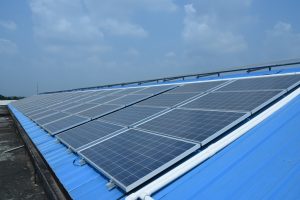On-Grid Solar Power Plants
CONCEPT
Install solar power panels on the roof, generate electricity, use the power during the day time and export to KSEBL (concerned service powder) earn a regular income. During night use the power from the KSEBL and if there is excess export during day it can be offset for the night use of power.

COMPONENTS
-
Solar Panel.
-
Solar On-Grid Inverter.
-
ACDB & DCDB and cables.
-
Module Mounting Structure.
-
Lightening Arrestor & Cabling.
-
Solar Check Meter & Bidirectional Meter.
ADVANTAGE
-
Effective replacement for electricity during day time.
-
Reduce the electricity bill substantially.
-
Low cost Investment.
-
Green Power So, Free of pollution.
-
Fetch a regular income through the sale of electricity.
-
The Power requirement for 25 years is budgeted.
-
No recurring cost.
-
Utilize full power generated by solar panel.
Grid-tied systems are the most common type and popular scheme in solar PV system. Grid-tied systems are connected to the local utility grid, and allow residents of a building to use both solar energy as well as electricity from the grid simultaneously. Grid-tied systems enable maximum utilisation of solar power during the sunshine hours, meeting load demand. When there is no demand for energy, the solar panels send excess electricity generated back out into the grid through a facility called ‘Net- Metering’ based on net metering agreement with their utility. The agreement allows utility customers to receive credit for the excess energy they generated, typically credited as a kilowatt-hour/Units credit on the next month’s bill.
Grid-tied systems do not provide protection from power outages. When the electrical grid fails, grid-tied systems will not continue to operate. This allows utility employees to fix the power lines safely without wasting time identifying solar energy systems that are still feeding electricity into the power lines.


